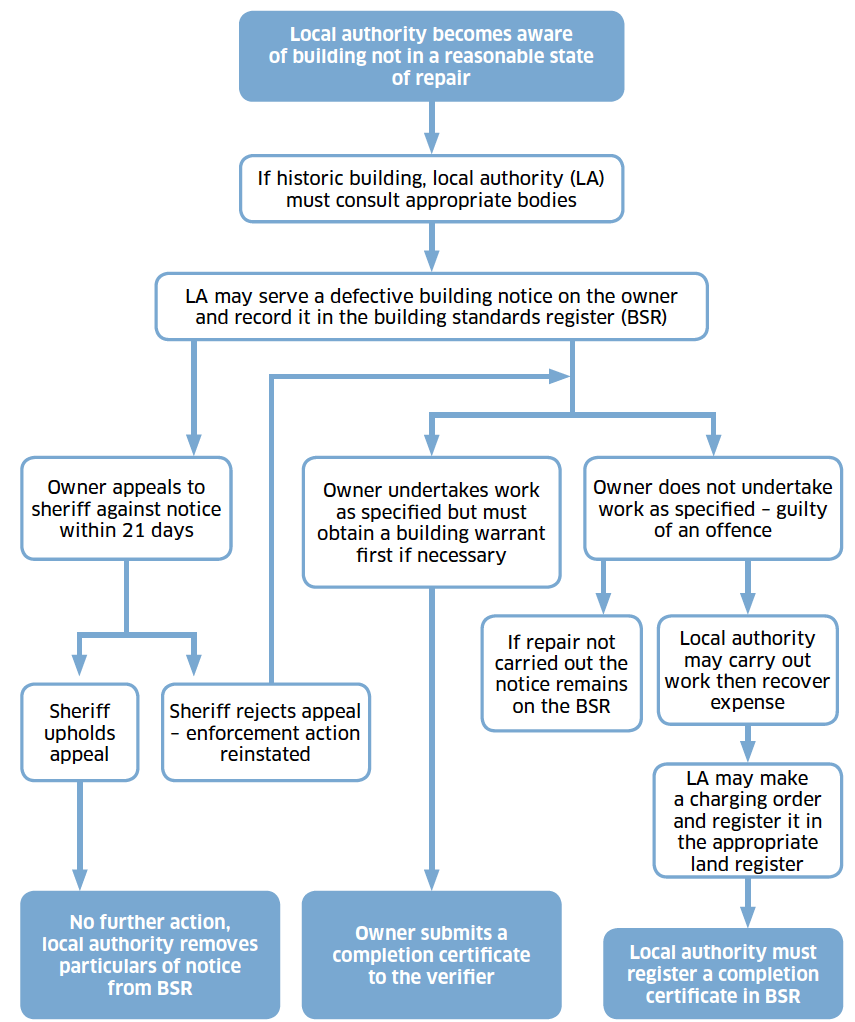Building standards: procedural handbook (third edition, version 1.6)
Clarifies procedures underpinning the Scottish building standards system as set out in the Building (Procedure) (Scotland) Regulations 2004 and the Building (Scotland) Act 2003 to help with practical operation.
This document is part of a collection
11 Defective buildings
11.1 Defective buildings notice
11.1.1. Where a local authority considers that a building has defects that require to be dealt with to prevent significant deterioration, it can serve a notice on the owner of the building. The Act describes the defects that can be dealt with as those ‘which require rectification in order to bring the building into a reasonable state of repair having regard to its age, type and location’. As with dangerous buildings notices, before serving a defective building notice it may be useful to call a meeting if the repairs are likely to be extensive or involve a variety of owners.
11.1.2. A defective buildings notice must specify a date, not less than seven days after service of the notice, by which the owner must have begun the work specified. The work must be completed by a second specified date, which must be not less than 21 days after the specified commencement date. The notice may also specify particular steps which the owner must take in complying with the notice. The issue of a notice must be recorded in the building standards register (see 7.7 for the consultation needed with Historic Environment Scotland on historic buildings). The notice requires the owner to inform the local authority when work is completed and a completion certificate is required whether or not work is done under a warrant.
11.1.3. Should the work be of a nature that does require a warrant, then this must be obtained before the work starts. To facilitate this, if a warrant has been applied for by the commencement date in the notice then a new commencement date is substituted, which is not less than seven days after the verifier considering the warrant has decided the application.
11.1.4. It should be noted that where the local authority issuing the notice is also a verifier, it can require the application for a warrant and subsequent completion certificate to be submitted to them.
This is to assist in the enforcement of the notice, because if an owner has not begun and completed the work by the specified dates the owner has committed an offence. The local authority also has the power to carry out the work necessary to fulfil the notice and to recover from the owner any expenses reasonably incurred in doing so. A local authority entitled to recover its costs may make a charging order in favour of itself and register it in the appropriate land register (see 10.8). Where the local authority does the work no warrant is required but on completion a completion certificate must be registered in the building standards register.
11.1.5. It should be noted that, although the power to issue notices has been removed from section 87 of the Civic Government (Scotland) Act 1982 by the Building (Scotland) Act 2003, other sub-sections are not repealed. For defective buildings therefore, the existing powers in the 1982 Act to rectify immediately and recover costs by charging order under section 108 remain. The link to entitlement to repairs grant, however, was repealed by the Housing (Scotland) Act 2006.
11.1.6. The local authority has the power to withdraw a defective buildings notice at any time or waive or relax any requirement of the notice or substitute a later date for any date specified for commencement or completion. The withdrawal does not prevent a future notice being issued should the local authority deem it necessary. Where a notice is withdrawn, this should be recorded on the building standards register.
Figure 13: defective buildings
Procedures Relating To Defective Buildings

Contact
Email: buildingstandards@gov.scot
There is a problem
Thanks for your feedback